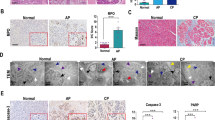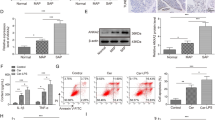Abstract
Uncoupling-protein 2 (UCP2) is a mitochondrial protein that appears to be involved in cellular oxidant defense and in the regulation of oncotic cell death, both of which are important features of acute pancreatitis. However, UCP2 expression in acute pancreatitis has not been previously reported. In the current experiments, pancreatic gene expression was studied by real-time reverse-transcription/polymerase chain reaction and Northern blots. Two models of acute experimental pancreatitis were investigated: cerulein-induced pancreatitis in mice at two different time points and taurocholate-induced pancreatitis in rats at two degrees of severity. After cerulein administration, acinar injury and leukocyte infiltration was significantly higher at 24 h compared with 12 h after the first injection of cerulein (P<0.05, P<0.005, respectively). UCP2 mRNA was unchanged at 12 h but was nearly 12-fold greater than control levels after 24 h (P<0.001). UCP2 gene expression correlated with acinar injury (r=0.69; P<0.001). By 72 h after taurocholate administration, the severe group had more necrosis than the mild group (P<0.005). Pancreatic UCP2 mRNA was increased fourfold in the severe group compared with controls (P<0.01). UCP2 expression correlated with parenchymal necrosis (r=0.61; P<0.01). Thus, pancreatic UCP2 mRNA increased in two models of acute pancreatitis. The increase in UCP2 gene expression was correlated with the severity of the disease. Up-regulation of UCP2 in the pancreas may be a protective response to oxidative stress, but this increase may also have a negative influence on cellular energy metabolism. Therefore, acinar UCP2 may be an important modifier of the severity of acute pancreatitis.




Similar content being viewed by others
References
Adrian TE, Zucker KA, Bilchik AJ, Modlin IM (1990) A novel micromethod for pancreatic acinar secretion. Time course of CCK stimulation and its inhibition by L-364,718. Int J Pancreatol 6:61–69
Aho HJ, Koskensalo SM, Nevalainen TJ (1980) Experimental pancreatitis in the rat. Sodium taurocholate-induced acute haemorrhagic pancreatitis. Scand J Gastroenterol 15:411–416
Alves-Guerra MC, Rousset S, Pecqueur C, Mallat Z, Blanc J, Tedgui A, Bouillaud F, Cassard-Doulcier AM, Ricquier D, Miroux B (2003) Bone marrow transplantation reveals the in vivo expression of the mitochondrial uncoupling protein 2 in immune and nonimmune cells during inflammation. J Biol Chem 278:42307–42312
Andersson R, Wang X (1998) Patterns of pancreatic cell death: apoptosis versus oncosis. Pancreas 17:281–288
Arsenijevic D, Onuma H, Pecqueur C, Raimbault S, Manning BS, Miroux B, Couplan E, Alves-Guerra MC, Goubern M, Surwit R, Bouillaud F, Richard D, Collins S, Ricquier D (2000) Disruption of the uncoupling protein-2 gene in mice reveals a role in immunity and reactive oxygen species production. Nat Genet 26:435–439
Cadenas S, Buckingham JA, Samec S, Seydoux J, Din N, Dulloo AG, Brand MD (1999) UCP2 and UCP3 rise in starved rat skeletal muscle but mitochondrial proton conductance is unchanged. FEBS Lett 462:257–260
Calvo EL, Boucher C, Coulombe Z, Morisset J (1997) Pancreatic GAPDH gene expression during ontogeny and acute pancreatitis induced by caerulein. Biochem Biophys Res Commun 235:636–640
Chavin KD, Yang S, Lin HZ, Chatham J, Chacko VP, Hoek JB, Walajtys-Rode E, Rashid A, Chen CH, Huang CC, Wu TC, Lane MD, Diehl AM (1999) Obesity induces expression of uncoupling protein-2 in hepatocytes and promotes liver ATP depletion. J Biol Chem 274:5692–5700
Chomczynski P, Sacchi N (1987) Single-step method of RNA isolation by acid guanidinium thiocyanate-phenol-chloroform extraction. Anal Biochem 162:156–159
Cortez-Pinto H, Zhi Lin H, Qi Yang S, Odwin Da Costa S, Diehl AM (1999) Lipids up-regulate uncoupling protein 2 expression in rat hepatocytes. Gastroenterology 116:1184–1193
Demols A, Van Laethem JL, Quertinmont E, Legros F, Louis H, Le Moine O, Deviere J (2000) N-acetylcysteine decreases severity of acute pancreatitis in mice. Pancreas 20:161–169
Ethridge RT, Chung DH, Slogoff M, Ehlers RA, Hellmich MR, Rajaraman S, Saito H, Uchida T, Evers BM (2002) Cyclooxygenase-2 gene disruption attenuates the severity of acute pancreatitis and pancreatitis-associated lung injury. Gastroenterology 123:1311–1322
Fleury C, Neverova M, Collins S, Raimbault S, Champigny O, Levi-Meyrueis C, Bouillaud F, Seldin MF, Surwit RS, Ricquier D, Warden CH (1997) Uncoupling protein-2: a novel gene linked to obesity and hyperinsulinemia. Nat Genet 15:269–272
Frossard JL, Saluja A, Bhagat L, Lee HS, Bhatia M, Hofbauer B, Steer ML (1999) The role of intercellular adhesion molecule 1 and neutrophils in acute pancreatitis and pancreatitis-associated lung injury. Gastroenterology 116:694–701
Frossard JL, Hadengue A, Spahr L, Morel P, Pastor CM (2002) Natural history of long-term lung injury in mouse experimental pancreatitis. Crit Care Med 30:1541–1546
Fujimoto K, Hosotani R, Doi R, Wada M, Lee JU, Koshiba T, Miyamoto Y, Imamura M (1997) Role of neutrophils in cerulein-induced pancreatitis in rats: possible involvement of apoptosis. Digestion 58:421–430
Gimeno RE, Dembski M, Weng X, Deng N, Shyjan AW, Gimeno CJ, Iris F, Ellis SJ, Woolf EA, Tartaglia LA (1997) Cloning and characterization of an uncoupling protein homolog: a potential molecular mediator of human thermogenesis. Diabetes 46:900–906
Halangk W, Matthias R, Schild L, Meyer F, Schulz HU, Lippert H (1998) Effect of supramaximal cerulein stimulation on mitochondrial energy metabolism in rat pancreas. Pancreas 16:88–95
Halangk W, Lerch MM, Brandt-Nedelev B, Roth W, Ruthenbuerger M, Reinheckel T, Domschke W, Lippert H, Peters C, Deussing J (2000) Role of cathepsin B in intracellular trypsinogen activation and the onset of acute pancreatitis. J Clin Invest 106:773–781
Horvath TL, Diano S, Miyamoto S, Barry S, Gatti S, Alberati D, Livak F, Lombardi A, Moreno M, Goglia F, Mor G, Hamilton J, Kachinskas D, Horwitz B, Warden CH (2003) Uncoupling proteins-2 and 3 influence obesity and inflammation in transgenic mice. Int J Obes Relat Metab Disord 27:433–442
Iovanna JL, Keim V, Michel R, Dagorn JC (1991) Pancreatic gene expression is altered during acute experimental pancreatitis in the rat. Am J Physiol 261:G485–G489
Kaiser AM, Saluja AK, Sengupta A, Saluja M, Steer ML (1995) Relationship between severity, necrosis, and apoptosis in five models of experimental acute pancreatitis. Am J Physiol 269:C1295–C1304
Krauss S, Zhang CY, Lowell BB (2002) A significant portion of mitochondrial proton leak in intact thymocytes depends on expression of UCP2. Proc Natl Acad Sci USA 99:118–122
Kruse P, Hage E, Lasson A (1999) Proteases and protease inhibitors in taurocholate-induced acute pancreatitis in rats. Int J Pancreatol 25:113–121
Lee FY, Li Y, Yang EK, Yang SQ, Lin HZ, Trush MA, Dannenberg AJ, Diehl AM (1999) Phenotypic abnormalities in macrophages from leptin-deficient, obese mice. Am J Physiol 276:C386–C394
Mills EM, Xu D, Fergusson MM, Combs CA, Xu Y, Finkel T (2002) Regulation of cellular oncosis by uncoupling protein 2. J Biol Chem 277:27385–27392
Negre-Salvayre A, Hirtz C, Carrera G, Cazenave R, Troly M, Salvayre R, Penicaud L, Casteilla L (1997) A role for uncoupling protein-2 as a regulator of mitochondrial hydrogen peroxide generation. Faseb J 11:809–815
Pecqueur C, Alves-Guerra MC, Gelly C, Levi-Meyrueis C, Couplan E, Collins S, Ricquier D, Bouillaud F, Miroux B (2001) Uncoupling protein 2, in vivo distribution, induction upon oxidative stress, and evidence for translational regulation. J Biol Chem 276:8705–8712
Poch B, Gansauge F, Rau B, Wittel U, Gansauge S, Nussler AK, Schoenberg M, Beger HG (1999) The role of polymorphonuclear leukocytes and oxygen-derived free radicals in experimental acute pancreatitis: mediators of local destruction and activators of inflammation. FEBS Lett 461:268–272
Rial E, Gonzalez-Barroso M, Fleury C, Iturrizaga S, Sanchis D, Jimenez-Jimenez J, Ricquier D, Goubern M, Bouillaud F (1999) Retinoids activate proton transport by the uncoupling proteins UCP1 and UCP2. Embo J 18:5827–5833
Ricquier D, Bouillaud F (2000) The uncoupling protein homologues: UCP1, UCP2, UCP3, StUCP and AtUCP. Biochem J 345:161–179
Rippe C, Berger K, Boiers C, Ricquier D, Erlanson-Albertsson C (2000) Effect of high-fat diet, surrounding temperature, and enterostatin on uncoupling protein gene expression. Am J Physiol Endocrinol Metab 279:E293–E300
Rousset S, Alves-Guerra MC, Ouadghiri-Bencherif S, Kozak LP, Miroux B, Richard D, Bouillaud F, Ricquier D, Cassard-Doulcier AM (2003) Uncoupling protein 2, but not uncoupling protein 1, is expressed in the female mouse reproductive tract. J Biol Chem 278:45843–45847
Sandoval D, Gukovskaya A, Reavey P, Gukovsky S, Sisk A, Braquet P, Pandol SJ, Poucell-Hatton S (1996) The role of neutrophils and platelet-activating factor in mediating experimental pancreatitis. Gastroenterology 111:1081–1091
Schoenberg MH, Buchler M, Younes M, Kirchmayr R, Bruckner UB, Beger HG (1994) Effect of antioxidant treatment in rats with acute hemorrhagic pancreatitis. Dig Dis Sci 39:1034–1040
Segersvard R, Sylvan M, Lempinen M, Larsson J, Permert J (2004) Impact of chronic and acute high-fat feeding on acute experimental pancreatitis complicated by endotoxinaemia. Scand J Gastroenterol 39:74–80
Skulachev VP (1998) Uncoupling: new approaches to an old problem of bioenergetics. Biochim Biophys Acta 1363:100–124
Spormann H, Sokolowski A, Letko G (1989) Effect of temporary ischemia upon development and histological patterns of acute pancreatitis in the rat. Pathol Res Pract 184:507–513
Telek G, Scoazec JY, Chariot J, Ducroc R, Feldmann G, Roz C (1999) Cerium-based histochemical demonstration of oxidative stress in taurocholate-induced acute pancreatitis in rats. A confocal laser scanning microscopic study. J Histochem Cytochem 47:1201–1212
Weiss SJ (1989) Tissue destruction by neutrophils. N Engl J Med 320:365–376
Yasar M, Mas MR, Comert B, Akay C, Deveci S, Yilmaz MI, Kocer B, Mas N, Doruk H, Kocar IH (2002) Has the oxidative stress a role in late phase of experimental acute necrotizing pancreatitis? Hepatogastroenterology 49:1692–1695
Yuan S, Rosenberg L, Ilieva A, Agapitos D, Duguid WP (1999) Early changes of gene expression during cerulein supramaximal stimulation. Pancreas 19:45–50
Zhang CY, Baffy G, Perret P, Krauss S, Peroni O, Grujic D, Hagen T, Vidal-Puig AJ, Boss O, Kim YB, Zheng XX, Wheeler MB, Shulman GI, Chan CB, Lowell BB (2001) Uncoupling protein-2 negatively regulates insulin secretion and is a major link between obesity, beta cell dysfunction, and type 2 diabetes. Cell 105:745–755
Acknowledgements
We thank Irene Engström, Beth Hagman, Ulla Gülich, and Maria Sylvàn for their skillful assistance.
Author information
Authors and Affiliations
Corresponding author
Additional information
This study was made possible by collaboration within the Pancreas 2000 project and was supported by grants from the Swedish Medical Research Council (K2003-73X-12665-06A and K2003-03X-07904-17C) and the Swedish Cancer Society (4572-B02-02XBB).
Rights and permissions
About this article
Cite this article
Segersvärd, R., Rippe, C., DuPlantier, M. et al. mRNA for pancreatic uncoupling protein 2 increases in two models of acute experimental pancreatitis in rats and mice. Cell Tissue Res 320, 251–258 (2005). https://doi.org/10.1007/s00441-004-1024-1
Received:
Accepted:
Published:
Issue Date:
DOI: https://doi.org/10.1007/s00441-004-1024-1




